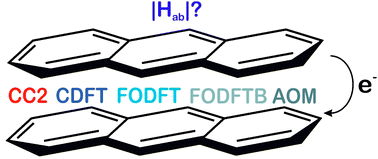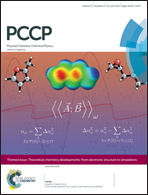Electronic couplings for molecular charge transfer: benchmarking CDFT, FODFT and FODFTB against high-level ab initio calculations. II†
Abstract
A new database (HAB7-) of electronic coupling matrix elements (Hab) for electron transfer in seven medium-sized negatively charged π-conjugated organic dimers is introduced. Reference data are obtained with spin-component scaled approximate coupled cluster method (SCS-CC2) and large basis sets. Assessed DFT-based approaches include constrained density functional theory (CDFT), fragment-orbital DFT (FODFT), self-consistent charge density functional tight-binding (FODFTB) and the recently described analytic overlap method (AOM). This complements the previously reported HAB11 database where only cationic dimers were considered. The CDFT method in combination with a functional based on PBE and including 50% of exact exchange (HFX) was found to provide best estimates, with a mean relative unsigned error (MRUE) of 8.2%. CDFT couplings systematically increase with decreasing fraction of HFX as a consequence of increasing delocalisation of the SOMO orbital. The FODFT method is found to be very robust underestimating electronic couplings by 28%. The FODFTB and AOM methods, although orders of magnitude more efficient in terms of computational effort than the DFT approaches, perform well with reasonably small errors of 54% and 29%, respectively, translating in errors in the non-adiabatic electron transfer rate of a factor of 2.4 and 1.7, respectively. We discuss carefully various sources of errors and the scope and limitations of all assessed methods taking into account the results obtained for both HAB7- and HAB11 databases.

- This article is part of the themed collection: Theoretical chemistry developments: from electronic structure to simulations

 Please wait while we load your content...
Please wait while we load your content...